
A Linux distribution is an operating system made from a software collection that includes the Linux kernel and, often, a package management system. Linux users usually obtain their operating system by downloading one of the Linux distributions, which are available for a wide variety of systems ranging from embedded devices and personal computers to powerful supercomputers.
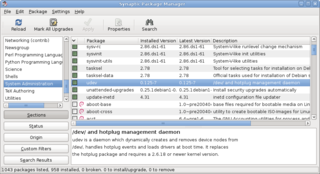
A package manager or package-management system is a collection of software tools that automates the process of installing, upgrading, configuring, and removing computer programs for a computer in a consistent manner.
Arch Linux is a Linux distribution created for computers with x86-64 processors. Arch Linux adheres to the KISS principle. The project attempts to have minimal distribution-specific changes, and therefore minimal breakage with updates, and be pragmatic over ideological design choices and focus on customizability rather than user-friendliness.

Kodi is a free and open-source media player software application developed by the XBMC Foundation, a non-profit technology consortium. Kodi is available for multiple operating systems and hardware platforms, with a software 10-foot user interface for use with televisions and remote controls. It allows users to play and view most streaming media, such as videos, music, podcasts, and videos from the Internet, as well as all common digital media files from local and network storage media.
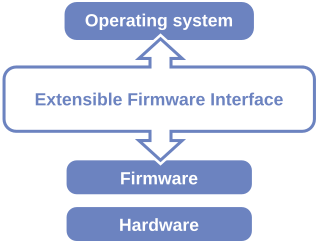
The Unified Extensible Firmware Interface (UEFI) is a publicly available specification that defines a software interface between an operating system and platform firmware. UEFI replaces the legacy Basic Input/Output System (BIOS) firmware interface originally present in all IBM PC-compatible personal computers, with most UEFI firmware implementations providing support for legacy BIOS services. UEFI can support remote diagnostics and repair of computers, even with no operating system installed.
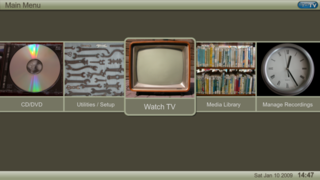
MythTV is a free and open-source home entertainment application with a simplified "10-foot user interface" design for the living room TV. It turns a computer with the necessary hardware into a network streaming digital video recorder, a digital multimedia home entertainment system, or home theater personal computer. It can be considered a free and open-source alternative to TiVo or Windows Media Center. It runs on various operating systems, primarily Linux, macOS, and FreeBSD.

A home theater PC (HTPC) or media center computer is a convergent device that combines some or all the capabilities of a personal computer with a software application that supports video, photo, audio playback, and sometimes video recording functionality. In recent years, other types of consumer electronics, including game consoles and dedicated media devices, have crossed over to manage video and music content. The term "media center" also refers to specialized application software designed to run on standard personal computers.

Ubuntu is a Linux distribution based on Debian and composed mostly of free and open-source software. Ubuntu is officially released in three editions: Desktop, Server, and Core for Internet of things devices and robots. All the editions can run on the computer alone, or in a virtual machine. Ubuntu is a popular operating system for cloud computing, with support for OpenStack. Ubuntu's default desktop has been GNOME since version 17.10.

Hauppauge Computer Works is a US manufacturer and marketer of electronic video hardware for personal computers. Although it is most widely known for its WinTV line of TV tuner cards for PCs, Hauppauge also produces personal video recorders, digital video editors, digital media players, hybrid video recorders and digital television products for both Windows and Mac. The company is named after the hamlet of Hauppauge, New York, in which it is based.
Technical variations of Linux distributions include support for different hardware devices and systems or software package configurations. Organisational differences may be motivated by historical reasons. Other criteria include security, including how quickly security upgrades are available; ease of package management; and number of packages available.

Debian-Installer is a system installer designed for the Debian Linux distribution. It originally appeared in the Debian release 3.1 (Sarge), released on June 6, 2005, although the first release of a Linux distribution that used it was Skolelinux (Debian-Edu) 1.0, released in June 2004.

Software remastering is software development that recreates system software and applications while incorporating customizations, with the intent that it is copied and run elsewhere for "off-label" usage. The term comes from remastering in media production, where it is similarly distinguished from mere copying.

Fedora Linux is a Linux distribution developed by the Fedora Project which is sponsored primarily by Red Hat with additional support and sponsors from other companies and organizations. Fedora contains software distributed under various free and open-source licenses and aims to be on the leading edge of open-source technologies. Fedora is the upstream source for Red Hat Enterprise Linux.
LinuxMCE is a free and open source software platform with a 10-foot user interface designed to allow a computer to act as a home theater PC (HTPC) for the living-room TV, personal video recorder, and home automation system. It allows control of everything in the home, from lighting and climate to surveillance cameras and home security. It also includes a full-featured VoIP-compatible phone system with support for video conferencing.

Microsoft Hyper-V, codenamed Viridian, and briefly known before its release as Windows Server Virtualization, is a native hypervisor; it can create virtual machines on x86-64 systems running Windows. Starting with Windows 8, Hyper-V superseded Windows Virtual PC as the hardware virtualization component of the client editions of Windows NT. A server computer running Hyper-V can be configured to expose individual virtual machines to one or more networks. Hyper-V was first released with Windows Server 2008, and has been available without additional charge since Windows Server 2012 and Windows 8. A standalone Windows Hyper-V Server is free, but with command-line interface only.
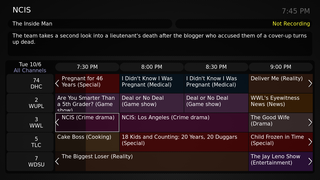
Mythbuntu is a discontinued media center operating system based on Ubuntu, which integrated the MythTV media center software as its main function, and did not install with all of the programs included with Ubuntu.

GB-PVR was a PVR application, running on Microsoft Windows, whose main function was scheduling TV recordings and playing back live TV. GB-PVR is no longer under active development and has been superseded by NextPVR, also known as nPVR.
OpenELEC was a Linux distribution designed for home theater PCs and based on the Kodi media player.
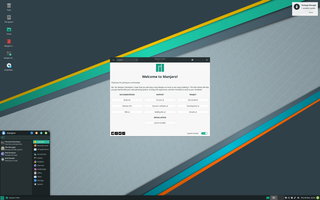
Manjaro is a free and open-source Linux distribution based on the Arch Linux operating system. Manjaro has a focus on user-friendliness and accessibility. It features a rolling release update model and uses Pacman as its package manager. Manjaro is mainly developed in Austria, France and Germany.
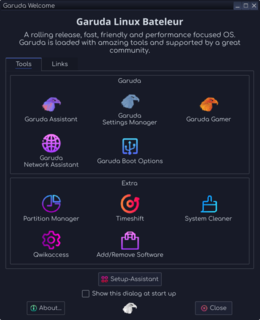
Garuda Linux is a Linux distribution based on the Arch Linux operating system. Garuda Linux is available in wide range of popular Linux desktop environments, including modified versions of the KDE Plasma 5 desktop environment. It features a rolling release update model using Pacman as its package manager. The term Garuda, originates from Hinduism, which is defined as a divine eagle-like sun bird and the king of birds.















